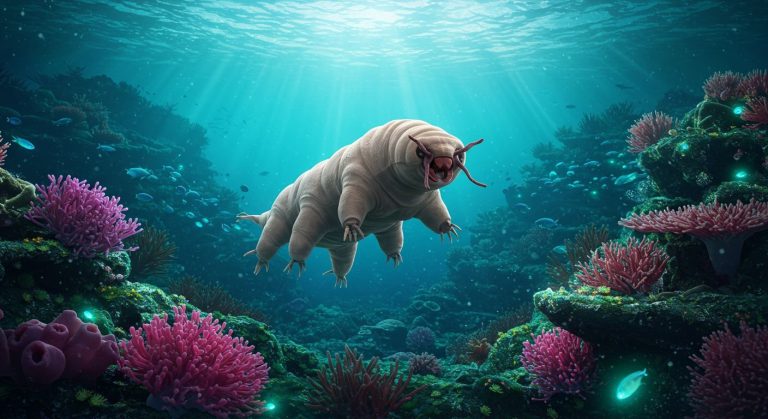Did you know . . . ?

The Tardigrade: one of the toughest microscopic creatures on earth!
🐾The tiny creatures called tardigrades (microscopic "water bears") can endure freezing, extreme heat, and even the intense radiation and vacuum in space; and they are said to have remained *unchanged* for ~600 million years!
Tardigrades are like nature’s ultimate survivalists wrapped in a cuddly exoskeleton. Here’s a list of their most outstanding traits, each one a testament to the design features manifest in creation:
🧬 Top Mind-Bending Facts About Tardigrades
🌌 1. They have Survived Outer Space
- In 2007, tardigrades were blasted into orbit and exposed to the rigours of space, cosmic radiation, and freezing temperatures. Many survived and reproduced after returning to earth!
🔥❄️ 2. They Endure Extreme Temperatures
- Tardigrades can survive from −272°C (just above absolute zero) to over 150°C. That’s colder than deep space and hotter than boiling water.
🧟 3. They Enter Cryptobiosis—A Zombie-Like State
- When conditions get tough, they curl into a dry husk called a “tun,” suspending metabolism almost completely. In this state, they can survive decades without food or water.
🦠 4. They’ve Been Around for 600 Million Years
- Tardigrades are said to predate dinosaurs by hundreds of millions of years. They’ve weathered all the mass extinction events scientists say have wiped out multitudes of species.
🧪 5. They’re Radiation-Resistant
- These tiny creatures can withstand radiation doses hundreds of times higher than levels that would kill a human.
🧭 6. They Live Practically Everywhere
- From Himalayan peaks to deep-sea trenches, Antarctic ice to tropical rainforests, tardigrades thrive in moss, lichen, soil, and even hot springs.
🧠 7. Their Bodies Are Mostly “Head”
- They don’t have the middle body segments typical of other creatures. Their entire body is essentially a walking head, anatomically speaking.
🐾 8. They Walk Like Bears
- Their lumbering gait and clawed feet resemble a bear’s walk—hence their nickname “water bear.”
🧫 9. They’re Transparent and Tiny
- Most are a fraction of a millimetre long—just visible to the naked eye—and many are translucent, making them hard to spot without a microscope.
🧃 10. They Feed by Piercing Cells
- Tardigrades use dagger-like mouthparts to pierce plant cells, algae, or even other tardigrades, then suck out the contents like microscopic vampires.
Mainstream evolutionary narratives lean heavily on the concept of incremental changes across immense spans of geologic time. But the tardigrade defies this theory in spades! They retained key anatomical traits for over half a billion years. This takes palaeontologists back in time to what they call the Ediacaran Period (541–635 million years ago), which is said to have marked the dawn of complex multicellular life. But are tardigrades really just “multicellular life”?
With all the mature characteristics that tardigrades manifest, to this day, are they not advanced with the so-called “evolutionary traits”? Where did these come from? Yet why are they “unchanged” in the face of the “evidence” that is touted to support evolutionary theory? Additionally, why are there no transitional forms that give rise to their incredible abilities? The answer given by evolutionists is most often along the lines of ‘fossilization is a rare event and the fossil record cannot be expected to contain a complete, uninterrupted sequence of evolution.’
The oft-cited phrase ‘cannot be expected’—when used to explain missing transitional fossils—implicitly acknowledges the incompleteness of the fossil record. If this foundational record is riddled with significant gaps, what other empirical pillars uphold the evolutionary framework? — (See the full article Mutations: Are They "Raw Materials" for Evolution?)

So tiny, they feed by piercing cells! (Note that this mage is not actually to scale!)

So resilient and morphologically stable, they challenge assumptions about adaptation!

A New Approach
The human capacity for unlimited creativity and design accomplishments is evident in what we have achieved and can achieve; and this capacity mirrors what we observe around us!
There are many books available on the theory of evolution and the "survival of the fittest," and there is no shortage of teachers on the topic.
But how much of the theory is actually derived from empirical evidence (that is, "verifiable by observation, experience, or experimental procedure")?
Does this question really matter?
The articles on this website include a new approach to the subject of evolution using considerations you will probably not find elsewhere, and they demonstrate why this is important to you!
What Do the Facts Say?
Many Parts — One Purpose!
The article 'Multiple Distinct Laws — One Function' presents a series of examples in which disparate laws of physics and nature—each autonomous in principle—converge toward a singular, life-enabling or life-enhancing function.
In each case, we observe a multitude of interdependent components, yet only one emergent outcome. Can such intricate coordination truly arise from an undirected process? Across countless examples, the absence or failure of even one part would render the overall function void.
Can a purposeless process truly account for such intricate coordination—where multiple independent laws align to produce life-enabling or life-enhancing outcomes? In numerous examples—far too many to catalogue exhaustively—the absence or malfunction of even a single component would compromise the entire function!
Without these functions, the delicate balance of nature would collapse—yielding a universe either inhospitable to life or incapable of sustaining it altogether.
Can a process devoid of foresight really coordinate the complex interplay of physical laws, biological systems, and environmental conditions to yield a universe finely tuned for earth, and an earth finely tuned for life?
The examples discussed in the article demonstrate not only order and arrangement, but also purposeful intent—even forward planning. They reveal a choreography of laws that suggests not just order, but orchestration.
The article presents a clear challenge: can evolution, unaided by foresight, account for every complex, organised function without disrupting the balance and order we observe?
For those who regard evolution as firmly established in mainstream science, Multiple Distinct Laws — One Function offers a thought-provoking and rewarding read.

What do
Scientists Say?
Mutations: Are They "Raw
Materials" for Evolution?
Mutations — radical genetic changes in living organisms — are often described as the ‘raw material’ of evolution.
Molecular biologist Jacques Monod once said regarding mutations: “Pure chance, absolutely free but blind, at the very root of the stupendous edifice of evolution… the only hypothesis that squares with observed and tested fact. And man has to understand that he is a mere accident.”
But is this foundation truly "secure"? Does it really "square with observed and tested fact"? Even among evolution’s supporters, scientific views on mutations remain divided. If meaningful mutations were as frequent and impactful as claimed, the vast timescales proposed by evolutionary theory ought to have left behind abundant evidence of gradual transitions. Yet, as the accompanying article demonstrates, such evidence remains conspicuously absent.
Some of the other topics considered on this website:
Intentional Order and Arrangement
Note the first three images displayed below. Which of them would you say does not manifest evidence of intentional order and arrangement?
(1) A Coded Message from Earth
The first image is a simplistic human figure using a basic pattern of 90 black and white squares. It was sent into deep space by a team of scientists in 1974.
Along with some other shapes, it was intended to prove to would-be aliens potentially listening (or rather, watching) somewhere in deep space, that it was designed and transmitted by an intelligent race of beings, that it originated from an intelligent source.
Would you agree that this qualifies as intentional order and arrangement?
For more details, see the Arecibo page.
(2) A Primitive Crafted Device
This is a tool fashioned from a piece of flint, like many that have been unearthed at numerous dig sites around the world.
Scientists at times send these artefacts to a museum as they present evidence that they were intentionally fashioned for use as a tool!
But how would you rate the achievement of this construction when compared to the design of the human tooth? Would you conclude that the crudely designed flint was the product of intentional and purposeful design, but that, by contrast, the human tooth is merely a result of trillions of consecutive undirected serendipitous events?
What do you think?
(3) A Mini Metropolis: The Living Cell
This image is an artist's representation of the interior of a human cell.
There are around 37 trillion of these (37,000,000,000,000) that make up the average-sized person's body. And they all function cooperatively for the good of the entire body.
Did you know that every cell in the human body (with the one exception of specialised red blood cells) builds and maintains billions of microscopic organic machines? [See the article 'Metropolis' The Living Cell.]
When you compare the expertise, preparation, design work, and ingenuity that went into the development of the impressive 'Arecibo image' (the Coded Message from Earth) by scientists, with the intricate and highly complex human cell, one cannot help but marvel at the amazing sophistication of the cell's design.
While the Arecibo image showcases human creativity and intelligence, the human cell exemplifies a level of complexity, order, and precision that has no equal in human creations.
Would you agree that this also qualifies as intentional order and arrangement?
Which Is the Odd One Out?
Of the three items illustrated here, which would you say was the odd one out?
How many of these items portrayed here fit the category of "intentional precise order and arrangement"?
According to exponents of the theory of Evolution, the item that is the odd one out happens to be by far the most complex and intelligently arranged — the human cell. . .
+ + + + + + + + + +
But the cell seems to be unique to Evolutionists, not because of its impressive design features, functionality, and well-arranged complexity, but because, in their opinion, it is the only one of these three items that was not the product of intentional precise order and arrangement!
Would you agree with that conclusion?
Contact us
Email: designomics@outlook.com










